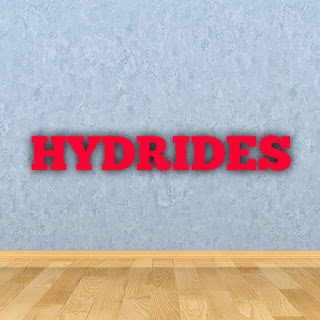Compounds of Hydrogen
Hydrides:
Hydrides are binary compounds of hydrogen.In which hydrogen remain as the anion or negatively charged ion H–.Its general formula is MHx or MxHy.
The various elements which form hydrides are:
- All the main group elements except those of nobles gases and probably indium and thallium.
- All lanthanides and actinides.
- Transition elements like –Sc, Y, La, Ac, Tc, Zr and Hf. V, Nb, Ta, Cr, Cu and Zn can form hydrides to lesser extent.
Metals of groups- 7, 8 and 9 hardly form hydrides and thus the region (group- 7 to 9) in periodic table is known as hydride gap.
Types of hydrides

Saline or Ionic hydride:
These hydrides are formed when hydrogen combines with elements which possess electronegativity value lower than that of hydrogen (2.1). Thus all alkali metals and alkaline earth metals can form ionic hydrides by transferring one electron from the metal ion to hydrogen atom.
Preparation:
Ionic hydrides can be prepared directly on passing hydrogen gas over alkali metals or alkaline earth metals heated at 322-7000C under pressure.
2Li +H2→2LiH
Ca + H2→CaH2
Physical Properties:
- Ionic hydrides are non-volatile, non-conducting white crystalline solid.
- Ionic hydrides are thermally stable solids. With the increase in the size of the metal ion, the lattice energy of these hydrides decreases thus, their thermal stability decreases from LiH to CsH: LiH>NaH>KH>RbH>CsH.
- In a similar way, hydrides of alkaline earth metals decrease in the order: CaH2> SrH2>BaH2.
- They have high melting and boiling point.
- They have high density, generally higher than that of the metals from which they are formed as the hydride ion occupy the holes in the lattice of the metal without distorting the metal lattice.
- They have high heat of formation.
- In molten state, they conduct electricity with the liberation of hydrogen at the anode.
NaH(molten ) →Na+ + H–
At Cathode: Na+ + e→Na
At anode: 2H–→H2 + 2e
Chemical properties:
- They react vigorously with water to produce corresponding metal hydroxides with the liberation of hydrogen. They act as a strong bases.
2MH + 2H2O→2MOH + 3H2
MH2 + 2H2O→M(OH)2 + 2H2
Due to the exothermic nature of the reaction, the evolved hydrogen catches fire.
- They burn in air on strong heating to produce hydrogen and the corresponding metal.
CaH2→Ca + H2
- At high temperature, they act as a powerful reducing agent.
2CO + NaH→HCOONa + C
CO2 + NaH→HCOONa
2BF3 + 6NaH→B2H6 + 6NaF
SiCl4 + 4NaH→SiH4 + 4NaCl
PbSO4 + 2CaH2 →PbS + 2Ca(OH)2
6LiH + N2 →2Li3N + 3H2
- Uses:
- Ionic hydrides ( LiAlH4, NaBH4etc.) are used as a powerful reducing agent in organic chemistry and metallurgical process.
- They can be used to produce hydrogen gas.
- They are used as a dehydrating agent for organic solvents.
- They are used as solid fuels.
Metallic or Interstitial hydrides:
d-Block elements of group-3,4,5 ,Cr from group-6 ,10,11,12 and f-block elements and can form metallic hydrides. They are alloys or interstitial solid solutions of hydrogen in metals. These hydrides exhibit properties similar to those of the parent metal and hence are called metallic hydrides. In these hydrides, hydrogen atom occupies the interstitial space of the metal lattice producing distortion without any change of its type.That is why these hydrides are called interstitial hydrides. Recent studies have shown that except for hydrides of Ni, Pd, Ce and Ac, other hydrides have different lattice from that of the parent metal.
- Properties:
They are hard, have metallic lustre, magnetic property and can conduct electricity.
These hydrides are often non stoichiometric like LaH2.87, YbH2.55, TiH1.5-1.8, ZrH1.3-1.75, VH0.56, NiH0.6-0.7, PdH0.6-0.8etc. The ratio of the hydrogen atoms to the metal atom are not fixed but vary with temperature and pressure.
- Uses:
- They are used as an adsorbent of hydrogen.
- They can be used as a reducing agent in organic chemistry.
Molecular or covalent hydrides:
Normally p-block elements and Be and Mg of s-block show this type of hydrides. Covalent hydrides are formed due to the fact that the electronegativity difference between these elements and hydrogen is low. The general formula of these hydrides is XHn and XH8-n for s-block and p-block respectively and n is the number of valence electrons. These hydrides exist as discrete molecules which are held together by van der Waal’ forces of attraction and thus are called covalent or molecular hydrides.
- Classification of molecular hydrides:
Based on their relative number of electrons and bonds present in their Lewis structure, covalent hydrides are classified as-
- Electron-deficient hydrides: The monomer of these hydrides have incomplete octet in the valence shell of the central atom. The elements of group-13 form this type of hydrides which gain stability through the formation of dimers ( B2H6, Ga2H6, etc.) and polymers [(AlH3)n,[(GaH3)n, [(InH3)n]
- Electron precise hydrides: The central atom of these hydrides possesses the exact number of electrons. The elements of group -14 form this type of hydrides such as CH4, SiH4, GeH4etc. These hydrides are tetrahedral in shape.
- Electron-rich hydrides: The central atom of these hydrides possesses more number of electrons in the valence shell of the central atom. The excess electrons are present in the form of lone pairs. The elements of group -15 to 17 form this type of hydrides such as NH3, H2O, HCl, H2Setc.
- Nomenclature:
The systematic name of the molecular hydrides is usually derived from the name of the elements by attaching ‘ane’ as a suffix. PH3 as phosphane, H2O as oxidane, NH3 as azine, H2S as sulphaneetc. Although phosphine, water, ammonia, hydrogen sulphide are commonly used.
- Preparation:
- By the direct combination of hydrogen with the element:
- N2 + 3H2 →2NH3
- 2H2 + O2 →2H2O
- H2 + S→H2S
- H2 + F2 →2HF
- By reduction of halides with LiAlH4 in the dry ether:
4BCl3 + 3LiAlH4 →2B2H6 (Diborane)+ 3AlCl3 + 3LiCl
SiCl4 + LiAlH4→SiH4 (Silane)+ LiCl + AlCl3
SnCl4 + LiAlH4→SnH4 (Stannane)+ LiCl + AlCl3
GeCl4 + LiAlH4→GeH4 (Germane)+ LiCl + AlCl3
3. By action of acids on suitable compounds:
2Mg3B2 + 4H3PO4→B4H10 + 2Mg3(PO4)2 + H2
Al4C3 + 12HCl→3CH4 + 4AlCl3
FeS + H2SO4 →H2S + FeSO4
Ca3P2 + 3H2SO4→2PH3 + 3CaSO4
4. By hydrolysis of metal carbides, nitrides, phosphides:
Al4C3 + 12H2O→4Al(OH)3 + 3CH4
Ca3N2 + 6H2O→3Ca(OH)2 + 2NH3
Ca3P2 + 6H2O→3Ca(OH)2 + 2PH3
5. By reduction of an oxoacid:
4H3AsO3 + 3NaBH4 → 4AsH3 + 3H3BO3 + 3NaOH
- Physical properties:
- These hydrides exist as gases, liquids, or solids of low melting and boiling points.
- They are bad conductors of electricity.
- They are soluble in organic solvents as they are covalent in nature.
- The hydrides of the first element of group- 15,16 and 17 i.e, ammonia, water and hydrogen fluoride have abnormally high boiling points as compared to the hydrides of other elements of each group. The abnormally high boiling point of these compounds is mainly due to intermolecular hydrogen bonding.
- Chemical properties:
- Electron-rich hydrides behave as Lewis bases while electron-deficient hydrides behave as Lewis acids.
- They undergo thermal decomposition to produce respective element. The thermal stability in a group decreases as the electronegativity decreases with an increase in size of the central atom down the group. NH3> PH3>AsH3>Sb3>BiH3
Polymeric hydrides:
This type of hydrides can be found in Be, Si, Ga, Al etc.(electronegativity in the range 1.40-2.0). In this type of hydride, the monomeric units are held by hydrogen bridges to form a polymeric structure. Some common examples are (BeH2)n, (AlH2)n, (InH2)n, (GaH2)n, (SiH2)n, etc.
Complex hydrides:
They are salts where the anion contains the hydride.NaAlH4, LiAlH4, LiBH4, NaBH4 are examples of complex metal hydrides. They are soluble in ethereal solvents. They are mainly used as reducing agents in organic reactions.















